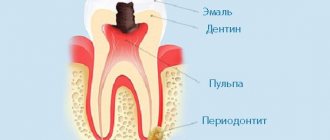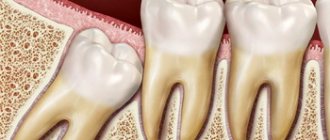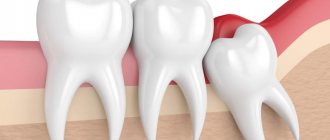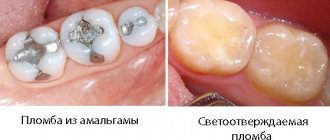Content:
- When is elevated temperature normal?
- When to sound the alarm
- If there is bleeding
- What problems may fever after wisdom tooth extraction indicate? 4.1. Alveolitis 4.2. Sinusitis 4.3. Hematoma 4.4. Leaving roots in the hole
- What to do
A person who has had a wisdom tooth removed should be aware that it is highly likely that his body temperature will rise in the near future.
But this does not mean that any ailment after surgery can be attributed to the classical course of regeneration processes. It also happens that a high temperature indicates unwanted complications. Thus, the temperature after the removal of a wisdom tooth can be a normal variant or a dangerous “bell” . The most reasonable thing to do when increasing it is to consult with the specialist who performed the dental surgery.
Eruption of wisdom teeth: symptoms
The duration of symptoms of the eruption of a wisdom tooth will depend on the availability of sufficient space in the dentition for its eruption, as well as on the position of the tooth in the jaw. If there is not enough space for eruption, it can only partially erupt (for example, by one or several cusps of the crown part of the tooth). The tooth can remain in this state for many years and decades - until it moves the tooth in front and makes room for itself.
All this time, you may feel periodic discomfort, especially pronounced during periods of colds. Also, the cause of difficult eruption may be the incorrect orientation of the tooth in the jaw, for example, it may begin to erupt at a strong angle to the 7th tooth in front (resting against it with the cusps of the crown part). Unfortunately, this process will be accompanied not only by negative symptoms of teething, but will also lead to the gradual destruction of the crown of the 7th tooth.
Destruction of the crown of the 7th tooth during the eruption of a wisdom tooth –
Eighth teeth that have difficulty erupting (due to horizontal position or lack of space in the dentition) are usually called impacted. Dentists most often recommend removing such teeth to prevent displacement and crowding of the front teeth, or damage to the teeth in front. You can read more about the indications for deletion/saving at the link below.
→ Indications for wisdom teeth removal
When is elevated temperature normal?
Very often, after a tooth is pulled out, a person experiences various unpleasant symptoms. They are due to the fact that the figure eight has long and winding roots. It is also far away and always difficult to get to. In the absence of free access to the crown, removal always turns out to be quite traumatic.
In the first two days after extraction of the unit, the following phenomena are considered normal:
- increase in body temperature to 37-38°C;
- swelling and redness of the socket;
- pain in the wound area;
- general weakness.
If healing proceeds without complications, these symptoms disappear within one to two days. Of course, swelling and soreness take longer to go away, but body temperature should not remain elevated for a long time.
Why do wisdom teeth hurt?
The appearance of a figure eight is often accompanied by fever, pain radiating to the ear, neck, enlarged submandibular lymph nodes, swelling and redness of the gums. There are many reasons why a wisdom tooth hurts; painful eruption is often associated with the following situations:
- Formation of the “hood”
- in an adult, the gum tissue is denser than in a child. Because of this, cutting through the figure eight is difficult. When only part of the tooth has erupted, and the other still remains under the gum, a section of tissue covering the erupted crown forms a specific hood. It makes further eruption of the molar difficult. The cause of pain in this situation is the inflammatory process developing under the hood (pericoronitis). - Abnormal growth
– figure eights often grow incorrectly relative to the jaw arch. Since the dentition is formed, there is not enough space for the figure eight. It begins to grow towards the neighboring unit, and the pain covers not only the area of the erupting tooth, but the entire jaw.
If a wisdom tooth that has already erupted begins to hurt, the reasons are most often the following:
- Caries
– the outer molars are located in a hard-to-reach area; it is difficult to clean them well with a brush. Bacterial plaque accumulates more in this area, causing caries. - Pulpitis -
a carious lesion extends beyond the enamel, dentin, and affects the tissue of the pulp chamber (neurovascular bundle). Pulpitis is accompanied by severe, throbbing pain. Endodontic treatment of figure eights does not differ from the techniques applied to other dental units. - Periodontitis is
inflammation of the tissue around the tooth root. It can be acute or chronic. The cause of the development of periodontitis is untreated pulpitis, trauma to the eighth molar, depressurization of a previously filled root canal and penetration of infection into it, and incorrect position of the tooth in the row.
Unpleasant sensations can intensify with the development of diseases of the oral cavity, infection of the dental canals, the formation of cysts, and granulomas. If your wisdom tooth hurts badly, you should immediately consult a dentist.
When to sound the alarm
- It happens that removal turns out to be difficult. Then the doctor warns the patient in advance about possible complications and tells him to come for a follow-up appointment in the coming days. You should sound the alarm if:
- Symptoms of a viral disease are observed. Then the fever persists for longer than three days. Cough, runny nose, and throat congestion appear. Efficiency decreases.
- After one or two days the temperature does not decline, but on the contrary, begins to rise. If it stays at 38.5-39 degrees throughout the day, you should seek medical help as soon as possible.
- Signs of inflammation in the oral cavity have become more pronounced. The gums are more swollen, accumulations of pus are visualized in the socket area, and there is no blood seal. This indicates complications.
Dry socket is especially dangerous. They talk about it if a dense blood clot does not form at the site of the pulled out tooth. The wound remains open to infection, which means that regenerative processes do not proceed correctly.
If there is bleeding
After difficult removal of the figure eight, bleeding may occur. It needs to be installed, but it is not always possible to do this in a short time. In severe cases, the dental surgeon places sutures on the postoperative wound and performs tamponade. Then the patient is recommended to apply a cold compress to the cheek for some time. It helps stop bleeding and quickly relieve swelling.
It is very important to understand what causes bleeding after surgery. Among the most common reasons:
- arterial hypertension or a sharp one-time increase in blood pressure;
- the use of anesthetics containing adrenaline (such drugs help dilate blood vessels);
- injury to the wound with the tongue or foreign objects;
- taking medications that reduce blood clotting;
- performing heavy physical work shortly after the intervention.
If bleeding continues throughout the day, this is abnormal. In such a situation, it is recommended to make an appointment with a doctor.
What problems might a fever after wisdom tooth extraction indicate?
If the thermometer shows high numbers, progression can be assumed:
- alveolitis;
- sinusitis;
- hematomas.
This symptom also indicates the presence of remnants of dental roots in the socket. This is possible if an inexperienced or irresponsible doctor was responsible for the operation.
Alveolitis
It is a consequence of a dry socket or mechanical removal of a clot from a wound . An unclosed wound is subject to serious bacterial attack. As a result, the area where the root was located becomes infected. Alveolitis can be caused by:
- errors made by the doctor during extraction;
- unsatisfactory level of oral hygiene;
- simultaneous removal of several teeth at once;
- leaving a piece of root in the hole;
- eating too hot and irritating foods immediately after surgery;
- serious tissue damage during removal;
- untreated sore throat;
- infection in the wound during surgery;
- reduced immunity.
Inflammation begins in the alveolar process and quickly spreads to the bone. Focal suppuration appears. Then the temperature rises. You cannot treat alveolitis on your own; medications must be prescribed by a doctor.
Sinusitis
If the extraction is carried out carelessly, a small hole may form , compromising the integrity of the maxillary sinus. Then food debris and bacteria will begin to penetrate from the oral cavity into the paired paranasal sinus. Inflammation will develop. The temperature will rise, pain will appear in the bridge of the nose and forehead. Migraines may occur. Treatment of sinusitis should be immediate.
Hematoma
Occurs due to rupture of a blood vessel. It can be triggered by a jump in blood pressure, nervous experiences, or the patient’s genetic predisposition to capillary fragility.
With a hematoma, the temperature rises, the gums swell and increase in size, and turn blue. The intervention is not considered dangerous and does not require additional treatment. As a rule, the situation normalizes on its own within a few days.
Leaving roots in the hole
If, after pulling out a tooth, you are bothered by the feeling of swelling in the gums, it seems that there is a foreign body inside it, you need to seek dental help.
Roots in a hole are always a medical error. They need to be removed as soon as possible. Otherwise, inflammation will progress. Sometimes bone particles come out on their own, but you shouldn't hope for this to happen.
Wisdom tooth hurts: why does it happen and what to do
Does a tooth that has already erupted hurt?
If a wisdom tooth that has already erupted hurts, the cause may be:
- Caries. Pain occurs when you eat sour, sweet or cold food. Such symptoms are usually short-lived. A situation is possible in which the growth of a wisdom tooth contributes to the destruction of the neighboring tooth, the seventh. Caries of this tooth can be localized on the far surface and is diagnosed using an x-ray.
- Pulpitis of the wisdom tooth. The pain is paroxysmal in nature in acute pulpitis, or aching and periodic in the chronic form.
- Periodontitis. It can be acute - when when biting on a wisdom tooth, the pain intensifies and the gums swell, and chronic - it can occur without obvious symptoms. Sometimes, with chronic periodontitis, a cyst with purulent discharge may form on the gum. This is a very dangerous inflammatory process that can lead to ostiomyelitis.
Should wisdom teeth be removed?
The eruption of wisdom teeth is often accompanied by unpleasant symptoms and the presence of an inflammatory process. But still, the importance of “eights” cannot be underestimated. For example, a wisdom tooth can serve as a support for installing a prosthesis, and in the absence of neighboring painters, it helps preserve bone tissue. That is why only a doctor can make a decision about removal or treatment. It is necessary to study its location and take into account the presence of pain and external symptoms. If the treatment prognosis is favorable, the tooth can be saved.
Indications for wisdom tooth removal:
- When the figure eight is positioned horizontally. In this case, the growth of the wisdom tooth contributes to the destruction of the neighboring tooth, which causes the entire dentition to shift.
- The wisdom tooth grows towards the cheek. With such an incorrect position, the pain will intensify when chewing, and the cheek will be injured. Against the background of a permanent wound to the mucous membrane, stomatitis can develop.
- Destruction of a wisdom tooth due to pulpitis. This can happen both before the wisdom tooth erupts and after.
- With periodontitis, the tooth enamel is completely destroyed. Then the wisdom tooth must also be removed.
- In case of failed therapeutic treatment.
Removing a wisdom tooth is a rather complicated operation due to the inaccessibility and branching of the roots. A highly qualified dental surgeon is required, as well as compliance with all safety and sterility conditions. The removal itself is painless, as it is carried out using painkillers. But in the process, soft tissues are injured, so after the removal of the wisdom tooth and the cessation of anesthesia, the patient experiences pain. After a few days, the swelling finally subsides and the pain subsides. This is also facilitated by the prescription of antimicrobial drugs. After wisdom tooth removal, the doctor gives recommendations on nutrition, lifestyle, and hygiene for several weeks. Thanks to their observance, recovery occurs faster.
How to make the right decision
If, after diagnosis, the doctor advises removing the wisdom tooth, then of course you should follow the recommendation. Indeed, as wisdom tooth inflammation progresses, serious complications can arise, including jaw destruction.
Needless to say, there can be no talk of any folk remedies in this matter. When the inflammatory process of a wisdom tooth develops, it is almost impossible to eliminate the pain syndrome with the help of ointments and rinses. Self-medication can lead to worsening of the condition and complications. To prevent this from happening, all manipulations must take place in a clinical setting and under the supervision of a doctor.
The causes of pain and inflammation of a wisdom tooth are different. A competent specialist will help you figure out what to do in a specific situation. Therefore, if pain occurs in the figure eight area, it is better to immediately seek the advice and help of a dentist.
What to do
If the temperature does not exceed 38°C and persists no longer than two days, there is no need to worry. To improve well-being, the patient can take a non-steroidal anti-inflammatory drug selected by the doctor. If pain is severe, analgesics will come to the rescue.
If the temperature lasts longer than two days and exceeds 38°C, you should visit a dental surgeon. The doctor will determine what caused the complication and prescribe treatment. Taking antibiotics to speed up regenerative processes without consulting a specialist is unacceptable.
Treat or remove?
Although the eruption of the extreme molars causes a lot of discomfort, these units have their significance. They can become supporting teeth for prosthetics. After losing adjacent units, figure eights retain the volume of the jawbone. If your wisdom tooth hurts, treatment is selected after diagnostic measures.
The decision to keep or remove the figure eight is made by the dentist after studying the position of the tooth, the degree of tissue destruction, the severity of symptoms, etc. If, after diagnosis, the doctor recommends removing a molar, you must follow the advice. A diseased wisdom tooth not only threatens the health of the jaw (especially the lower one) and the entire row, it is a constant source of infection in the body. Therapeutic treatment is carried out in the absence of carious complications.










